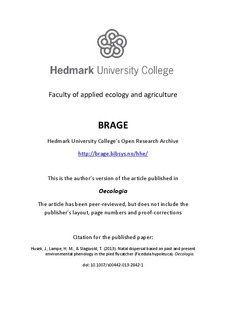Natal dispersal based on past and present environmental phenology in the pied flycatcher (Ficedula hypoleuca)
Journal article, Peer reviewed
Permanent lenke
http://hdl.handle.net/11250/134656Utgivelsesdato
2013Metadata
Vis full innførselSamlinger
Originalversjon
Husek, J., Lampe, H. M., & Slagsvold, T. (2013). Natal dispersal based on past and present environmental phenology in the pied flycatcher (Ficedula hypoleuca). Oecologia. doi: 10.1007/s00442-013-2842-1 10.1007/s00442-013-2842-1Sammendrag
Natal dispersal allows individuals to reach suitable
breeding sites. The effect of present plant phenology
as a cue for dispersal into areas with favourable stages of
development has been well established across avian and
mammalian taxa. However, the effect of past experience is
less understood. We studied the effect of past and present
phenology of the environment on the direction and distance
of natal dispersal in a passerine bird, the pied flycatcher
(Ficedula hypoleuca). We monitored spring settlement of
local recruits in six nest box plots along a 10-km stretch of
a south-north gradient of plant and caterpillar food development.
We found that males used both past experience of
caterpillar phenology from early life and actual plant phenology
during the recruitment season as independent cues
for breeding settlement. Males that had experienced a mismatch
with the caterpillar food peak as a nestling, and/or
those that arrived late in the spring in the recruitment year,
moved north of their natal site, whereas males that had
experienced a better match with the caterpillars as a nestling,
and/or those that migrated earlier in the spring, settled
at a similar site or more to the south. In females, no such effects were found, suggesting that the usage of phenological
cues is sex specific. In summary, tracking environmental
phenology by natal dispersal may represent an effective
mechanism for settling in new favourable areas, and may
thus potentially cause rapid change of a species’ geographical
breeding range in response to climate change.
Beskrivelse
this is the postprint version of the article. the published version of the article can be found at www.springerlink.com
